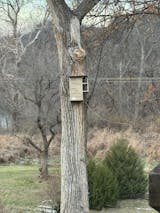Welcome to our blog, where we celebrate the wonders of wildlife and share tips on how to bring nature closer to your home. Today, we're diving into the world of the chickadee, a small but captivating bird that can bring joy and vibrancy to any outdoor space. Whether you're an avid birdwatcher or just starting your journey into birding, this guide will help you understand chickadees better and attract them to your yard.

What Do Chickadees Eat?
Chickadees are known for their varied diet, which makes them relatively easy to attract. These birds primarily feed on insects and spiders during the warmer months, providing natural pest control for your garden. In the winter, their diet shifts to seeds and berries. Some of their favorite foods include:
- Sunflower seeds: A top choice for chickadees, especially black oil sunflower seeds.
- Peanuts: Shelled and unsalted peanuts are a nutritious option.
- Suet: High-energy food that is particularly beneficial during colder months.
- Berries: Chickadees enjoy various berries, including elderberries and blueberries.
To attract chickadees, consider setting up feeders with these foods. Tube feeders and suet cages are excellent choices that cater to their feeding habits.

Where Do Chickadees Nest?
Chickadees are cavity nesters, meaning they prefer to nest in holes in trees or nest boxes. They often use abandoned woodpecker holes or natural cavities in trees. If you want to encourage chickadees to nest in your yard, you can provide nest boxes designed specifically for them. Here are some tips for setting up a chickadee-friendly nest box:
- Size: The entrance hole should be about 1 1/8 inches in diameter to keep out larger birds.
- Location: Place the nest box in a quiet area, ideally 5-15 feet above the ground.
- Materials: Use untreated wood to build the nest box, as treated wood can be harmful to birds.
- Maintenance: Clean the nest box annually to prevent parasites and diseases.

How Can I Attract Chickadees to My Yard?
Attracting chickadees involves creating a welcoming environment that meets their needs. Here are some strategies to make your yard irresistible to these charming birds:
- Food: Provide a variety of foods, including sunflower seeds, peanuts, and suet.
- Water: Set up a birdbath with fresh water. Chickadees appreciate a reliable water source for drinking and bathing.
- Shelter: Plant native trees and shrubs to offer natural shelter and nesting sites. Chickadees are particularly fond of coniferous trees.
- Nest Boxes: Install nest boxes to encourage chickadees to raise their young in your yard.
- Avoid Pesticides: Reduce or eliminate the use of pesticides to ensure a safe environment for chickadees and their insect prey.

Fun and Interesting Facts About Chickadees
Chickadees are fascinating birds with many unique traits. Here are some fun facts that highlight their charm:
- Name Origin: The name "chickadee" comes from their distinctive "chick-a-dee-dee-dee" call.
- Memory: Chickadees have an incredible memory, allowing them to remember the locations of hundreds of food caches.
- Adaptability: These birds can lower their body temperature during cold nights to conserve energy, a process known as torpor.
- Social Behavior: Chickadees are social birds that often form flocks with other small birds during the winter for better protection and foraging efficiency.

Different Chickadee Species in the US
There are several species of chickadees found across the United States, each with its own unique characteristics and range. Here are the most common species:
- Black-capped Chickadee: The most widespread chickadee species in North America, found from Alaska to the northern United States. They are easily recognizable by their black cap and bib, and white cheeks.
- Carolina Chickadee: Common in the southeastern United States, Carolina Chickadees look similar to Black-capped Chickadees but are slightly smaller and have a different song.
- Mountain Chickadee: Found in the mountainous regions of the western United States, these chickadees have a distinctive white eyebrow stripe.
- Chestnut-backed Chickadee: Native to the Pacific Northwest, these chickadees have a rich chestnut-colored back and sides.
- Boreal Chickadee: Inhabiting the boreal forests of Canada and the northern United States, Boreal Chickadees have a brown cap and a more subdued coloration.
- Mexican Chickadee: Found in the southwestern United States and Mexico, these chickadees have a distinctive black throat and are less common than other species.
- Gray-headed Chickadee: This rare species is found in Alaska and parts of Canada. It has a gray head and a more muted color palette compared to other chickadees.

Behavior and Ecology
Chickadees are active and inquisitive birds, often seen flitting about in search of food. They are known for their acrobatic feeding behavior, hanging upside down to access food. Chickadees are also vocal birds, using a variety of calls to communicate with each other. Their "chick-a-dee-dee-dee" call can signal alarm or help maintain flock cohesion.
In terms of ecology, chickadees play a vital role in controlling insect populations, making them beneficial for gardens and forests. They are also important seed dispersers, contributing to the health and regeneration of plant communities.

Creating a Chickadee-Friendly Habitat
To create an environment that attracts chickadees, consider the following additional tips:
- Diverse Plantings: Incorporate a variety of native plants that provide food and shelter throughout the year. Plants like serviceberry, dogwood, and elderberry offer berries that chickadees love.
- Dead Trees: If safe, leave dead trees or snags in your yard. These provide natural nesting sites and are rich in insects.
- Winter Shelter: Provide roosting pockets or dense shrubs where chickadees can take shelter during cold weather.
- Predator Protection: Install baffles on poles and nest boxes to deter predators like squirrels and raccoons.

Conclusion
Chickadees are delightful additions to any yard, offering beauty, entertainment, and ecological benefits. By providing food, water, shelter, and nesting sites, you can create a haven for these charming birds. Whether you're looking to enhance your birdwatching experience or simply enjoy the presence of wildlife, attracting chickadees to your yard is a rewarding endeavor.
Explore our range of outdoor bird and wildlife products to get started on creating a chickadee-friendly environment. From feeders to nest boxes, we have everything you need to welcome these wonderful birds to your home.
Happy birding!


